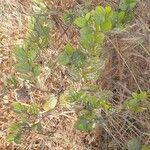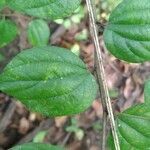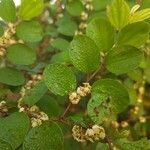Shrubs erect or scandent, spinose. Young branches densely ferruginous or yellow-brown pubescent; bark gray or gray-brown. Stipular spines 1, sometimes 2, one recurved and one erect, 3-4 mm; petiole 5-7 mm, densely yellow-brown pubescent; leaf blade ovate-oblong or ovate-lanceolate, 3-8 × 2-4 cm, papery, abaxially appressed pubescent to nearly villous, adaxially veins sparsely pubescent or glabrescent, 3-veined at base, veins prominent abaxially, conspicuously impressed adaxially, base usually ± asymmetric, subrounded, margin inconspicuously crenate, apex acute or acuminate. Flowers greenish yellow, few to 10 in axillary shortly pedunculate cymes. Pedicel ca. 2 mm, pilose. Sepals ovate-triangular, abaxially sparsely pilose to pubescent, adaxially glabrous, apex acute. Petals spatulate, clawed, enfolding stamens. Stamens slightly shorter than petals. Disk pentagonous, thick, fleshy, often 5-lobed. Ovary globose, glabrous, immersed in disk; style 2-branched. Drupe black, shiny, globose or obovoid-globose, small, 5-7 × 5-6 mm, base with persistent calyx tube, apex mucronulate; fruiting pedicel 3-4 mm, pilose; endocarp cartilaginous, ca. 2 mm; stone 1-or 2-seeded. Seeds shiny, globose. Fl. Aug-Sep, fr. Oct. 2n = 24.
More
Liane or scandent shrub 1–3 (–10) m high, with rusty-pubescent or-woolly young stems. Leaves: lamina ovate to broadly ovate, (20–) 35–55 (–70) mm long, (15–) 25–35 (–40) mm wide, obtuse, rarely cuneate or cordate base, serrulate margin, usually bluntly acuminate, occasionally obtuse or acute apex, ± concolorous, glabrous above, sparsely rusty-pubescent below; petiole 3–6 (–10) mm long; stipules 1–5 (–7) mm long. Inflorescence axes densely rusty-pubescent, flowers sparsely so. Pedicels 1–2.5 (–3.5) mm long. Hypanthium 1.6–2.2 mm diam. Sepals 1.2–1.6 mm long. Petals cucullate, 1.1–1.4 mm long. Stamens 1.1–1.4 mm long. Disc corrugate, glabrous. Ovary inferior; carpels 2; style 1.0–1.5 mm long. Fruit black, globular, 6–8 mm long.
A thorny shrub. It grows about 5 m high. It has straggling branches. The leaves are short stalked. The leaves are 2.3-5.5 cm long by 1.3-3 cm wide. They are oval to sword shaped. They taper to a tip. There are teeth around the edge. Leaves are unequal at the base. The flowers are yellowish. The fruit is fleshy with a hard covering over the seed. It is oval and yellow when fully ripe. There is a thin layer of acidic flesh around the seed.







